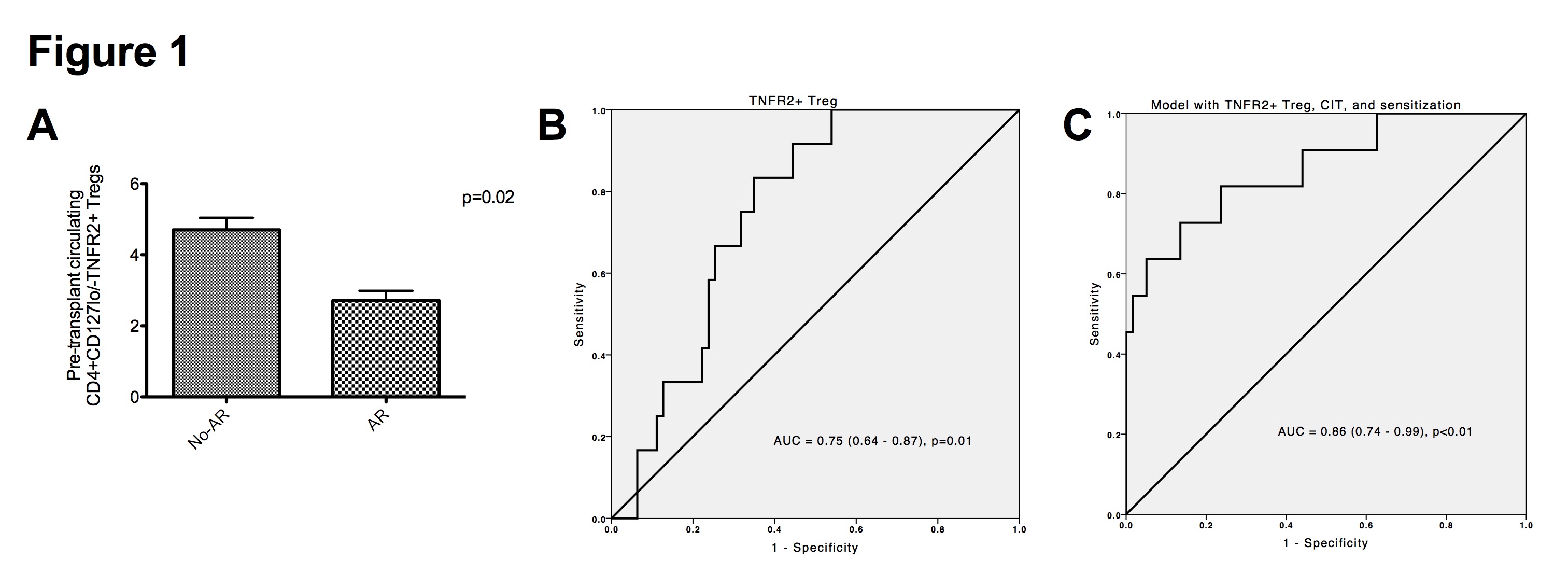Pre-Transplant Circulating TNFR2+ Regulatory T Cells Predict Acute Rejection within the First 6 Months After Kidney Transplantation.
1Department of Surgery, Columbia University, New York, NY
2Department of Surgery, McGill University, Montreal, QC, Canada
Meeting: 2017 American Transplant Congress
Abstract number: 84
Keywords: Kidney transplantation, Rejection, T helper cells
Session Information
Session Name: Concurrent Session: Predicting Tolerance and Rejection
Session Type: Concurrent Session
Date: Sunday, April 30, 2017
Session Time: 2:30pm-4:00pm
 Presentation Time: 2:54pm-3:06pm
Presentation Time: 2:54pm-3:06pm
Location: E351
Background: Acute rejection (AR) mostly occurs during the first 6 months after kidney transplantation and contributes importantly to graft loss. Diagnosis relies on changes in serum creatinine, but histological damage occurs prior. Regulatory T cells (Tregs) are critical in transplant tolerance. Their utility in the peri-transplant period to predict AR remains controversial due to the heterogeneity in their identification markers and immune suppressive function. Tumor necrosis factor receptor 2 (TNFR2) identifies a subset of maximally suppressive Tregs. We investigated whether pre-transplant circulating TNFR2+ Tregs predict AR within the first 6 months after kidney transplantation.
Methods: 75 deceased donor kidney transplant recipients were recruited. 12 developed biopsy-proven AR (11 acute cellular rejections [5 borderline, 3 1A, 2 1B], 1 antibody-mediated rejection). Donor, organ procurement, and recipient characteristics were similar between AR and non-rejector recipients except for cold ischemic time (CIT) and sensitization (PRA>50%). CD4+CD127lo/-TNFR2+ Tregs were quantified by flow cytometry in pre-transplant recipient peripheral blood.
Results: Pre-transplant TNFR2+ Tregs were significantly decreased in recipients who developed AR (2.74 ± 0.28%) compared to non-rejectors (4.70 ± 0.34%, p=0.02, Figure 1A). In univariate logistic regression, each percentage increase in TNFR2+ Treg decreased the odds of developing AR by 38% (p=0.02). TNFR2+ Treg also accurately predicted AR in receiver operating characteristic analysis with an area under the curve (AUC) of 0.75 (p=0.01, Figure 1B). In multivariate logistic regression adjusting for CIT and sensitization, TNFR2+ Treg remained a significant predictor of AR (OR=0.58, p=0.04). A model combining TNFR2+ Treg, CIT, and sensitization improved the predictive accuracy for AR (AUC=0.86, p<0.01, Figure 1C).
Conclusion: Pre-transplant circulating TNFR2+ Tregs predict AR during the first 6 months after kidney transplantation independently or in combination with CIT and sensitization.
CITATION INFORMATION: Nguyen M.-T, Sahakian S, Liu S, Wang Y, Tchervenkov J, Paraskevas S. Pre-Transplant Circulating TNFR2+ Regulatory T Cells Predict Acute Rejection within the First 6 Months After Kidney Transplantation. Am J Transplant. 2017;17 (suppl 3).
To cite this abstract in AMA style:
Nguyen M-T, Sahakian S, Liu S, Wang Y, Tchervenkov J, Paraskevas S. Pre-Transplant Circulating TNFR2+ Regulatory T Cells Predict Acute Rejection within the First 6 Months After Kidney Transplantation. [abstract]. Am J Transplant. 2017; 17 (suppl 3). https://atcmeetingabstracts.com/abstract/pre-transplant-circulating-tnfr2-regulatory-t-cells-predict-acute-rejection-within-the-first-6-months-after-kidney-transplantation/. Accessed December 22, 2025.« Back to 2017 American Transplant Congress
